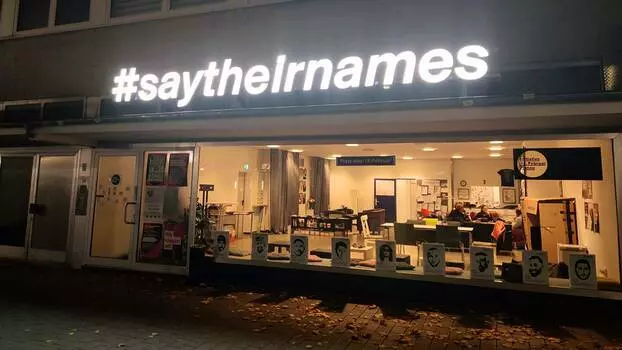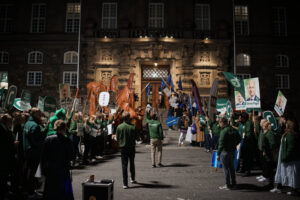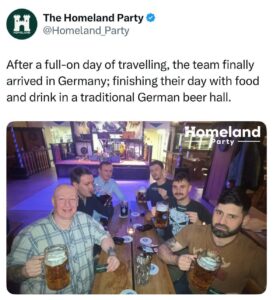After the attack of Hanau, which marks its second anniversary, public discourse about racist violence in Germany changed. One on hand it was preceded by little to no prevention attempts, and followed by usual failures of authorities: poor investigative work, cold and disrespectful treatment of the families of the victims, and the ritualized indignation of politicians without any serious consequences. Moreover, Hanau triggered an old trauma of non-white people living in Germany: the racist othering, the daily insults and threats, ultimately violence, and the experience that their lives are less worthy of protection or grief.
But the tireless work of the affected families and antiracist activists put the names and stories of the victims and families in the centre of attention. They highlighted racism as the main motive for the attack and thus countered the usual narrative of the „mentally disturbed single offender“. This time media, who use to make victims of racist violence invisible or spread authorities‘victim blaming, gave much more space to the voices of survivors and families, and the structural and social aspects of racism were broadly discussed.

Gökhan Gültekin, Sedat Gürbüz, Said Nesar Hashemi, Mercedes Kierpacz, Hamza Kurtović, Vili Viorel Păun, Fatih Saraçoğlu, Kaloyan Velkov and Ferhat Unvar lost their lives in the attack.
Photo: Massimo Perinelli
Two Years after Hanau: Political educational work put to the test
By Feben Amara, Rebecca Gotthilf, Efsun Kızılay, Lydia Lierke, and Massimo Perinelli. The authors are working for the Rosa-Luxemburg-Stiftung on the topic of migration.
Translated from Zwei Jahre nach Hanau for Gegensatz Translation Collective by Ryan Eyers and Marc Hiatt
Two years ago today, on 19 February 2020, a racist attack took place in Hanau that resulted in the deaths of nine people, most of them young. The attacker specifically targeted locations associated with the migrant community, including a bar, a betting agency, a shisha bar, and a corner store.
In contrast to the many racist and deadly attacks that have occurred in the past, the victims of Hanau and their relatives were neither stigmatized nor rendered invisible by the press, nor were they framed as attackers themselves—as had been the case with the series of murders committed by the NSU in the 2000s. Nor was the real attacker portrayed in the media as a deranged but apolitical lone wolf, and there were also fewer attempts to present the attacker’s motives in ways that people could understand and identify with, as had occurred with respect to the female member of the NSU to the point of absurdity. This is largely down to the efforts of the victims’ relatives and initiatives set up in the wake of previous attacks, which have in recent years engaged in the work of both painstaking research and public denunciation, thereby raising awareness for the central role that must be afforded to victims’ voices in the process of coming to terms with such atrocities.
Initially, however, we did witness the institutional reflex to ignore the demands, the needs, and the grief of the migrant victims’ families. On the night of the attack, for example, the relatives of the murdered victims were directed to a cold gymnasium, in which no support, no legal advice, no pastoral care, and no empathy was offered. Instead, families were left in the dark as to their relatives’ condition until the early hours of the following morning, when a list of the dead was read out by the police in a procedural fashion, after which the officials departed and left the families to fend for themselves. Another stark aspect of proceedings is the fact that the bodies of the murdered victims underwent autopsies without permission being sought from their families, who were first able to see them several days after the attack. Decisions were made without their consultation or involvement: another manifestation of how migrant families and victims experience institutional discrimination.
On the day after the attack, while a stage was hastily erected in Hanau to assist prominent politicians in their performance of a well-worn display of general dismay and helpless disbelief alongside expressions of the attack’s inexplicability, access to this stage was at first cynically denied to the victims’ families.
The motive was racism
This time around, however, the racist institutional reflex was not mirrored in the societal response. In Hanau there was no “attack after the attack”, the term used by those affected by the NSU terror attacks to describe the years of harassment and transformation of victims into perpetrators they were subsequently forced to endure at the hands of authorities and the media. A lot has happened in Germany in recent years. Thanks to years of prior resistance and struggle by migrant victims and their relatives, the press directly named racism as a motive for the Hanau attack. What’s more, despite the initial lack of visibility or platform afforded to them, the press eventually did (and subsequently continued to) pay attention to those actually left behind by the tragedy.
Even Volker Bouffier, who in 2006 in his role as Hesse’s Minister of the Interior put a stop to the targeted criminal investigation of Andreas Temme (intelligence agent for the Hesse State Office for the Protection of the Constitution) in connection with the murder of Halit Yozgat, and who had the files on the Office for the Protection of the Constitution’s entanglement with the case sealed for decades, was unable to avoid labelling the Hanau murders as racially motivated. For years after an NSU nail bomb exploded on Keupstrasse in Cologne’s Mühlheim district in 2004, the district mayor continued to refer to the street, home to numerous Turkish-German businesses, as a ghetto and to vilify its residents as criminals. The mayor of Hanau, by contrast, sought contact with the victims’ families and eventually pledged to support them.
The voices of those affected are of central importance
Something else also happened: on the third day after the attack, another stage was erected on Freedom Square in Hanau. Following a nationwide demonstration involving thousands of participants, friends and family of the victims gave speeches and shared their pain with the members of the public who had gathered there in solidarity. That which had previously taken years and sometimes even decades of campaigning to achieve—the centring of the voices of those affected, rather than them being made, as İbrahim Arslan put it, into “extras of their own stories”—here seemed able to occur within a matter of days. They came together. And they were not alone. Many of those directly affected by past attacks voiced their support, both online and in person, including the operators of Kiez-Döner in Halle, the site of a Nazi terror attack in October 2019; Candan Özer, the widow of one of the victims of the NSU nail bomb on Keupstrasse in Cologne (the victim died some time after the attack itself); survivors of the 1984 racist arson attack in Duisburg; a migrant activist and victim of racist violence from Neukölln in Berlin; a migrant spokesperson from the network Kein Schlussstrich (This is not over!); someone from the Hamburger Initiative für die Aufklärung des Mordes an Süleyman Taşköprü (Hamburg Initiative for a Full Investigation into the Murder of Süleyman Taşköprü); representatives from DIDF-Jugend; two members of Initiative Schwarze Menschen in Deutschland (Initiative for Black People in Germany; a Romani activist from Amaro Drom; representatives of the Initiative 6. April in Kassel ; and representatives of the “NSU-Komplex auflösen” (“Unravelling the NSU Complex”) tribunal.
One thing is clear: the migrant groups and initiatives that have organized in recent years around the perspectives of people affected by racist violence showed up in force and, drawing on their experiences, made it plain that forms neither of remembrance nor of anti-racist or anti-fascist action ought to focus on the actions of the perpetrators; rather they should be centred around those who are targeted by such violence and have always defended themselves against it. On the same day as the stage was erected on Hanau’s Freedom Square, the 19 February Initiative was formed from among the group of affected families and friends, and immediately set about building upon the hard-won paradigm shift of recent years, starting with the hashtag #saytheirnames.
Justice, investigations, and consequences
We know far more today than we did on the hectic, terror-stricken days immediately following the attack. Initially, “Hanau” functioned like a clarion call for thousands of young (post-)migrants across Germany to organize and make their voices heard. The summer of 2020 was strongly informed by a wave of prominent anti-racist and anti-fascist demonstrations and protests led by migrants and People of Colour strengthened and accelerated by the Black Lives Matter uprisings that occurred worldwide following the murder of George Floyd at the hands of US police just a few weeks after the events of 19 February. In Hanau, victims’ families and the 19 February Initiative opened a space in the city centre where relatives could come together each day to co-ordinate with one another and share in their grief. Despite being traumatized by the situation, they were also the ones who organized the work of remembrance and, in light of the “chain of failure” surrounding the tragedy, were vocal in their demands for “justice, investigations, and consequences”. Alongside this, friends of Ferhat Unvar, one of the victims, founded the Ferhat Unvar Educational Initiative together with his mother Serpil Temiz Unvar and a nationwide network of people standing in solidarity. Since then, the initiative has been active in holding anti-racist workshops in schools. December 2021 saw the beginning of the Hessian state parliament’s official commission of inquiry into the Hanau attack, with the 19 February Initiative and the victims’ families mobilizing their support base to attend the hearings. The inquiry is supposed to provide clarity—and lead to meaningful consequences. For this reason, Hanau residents commissioned an investigation by Forensic Architecture (a research agency active in investigating previous instances of racist and right-wing violence), who produced a report which showed statements made by the state prosecutor concerning the locked emergency exit in the Arena bar (one of the crime scenes) to have been false. With the support of other campaigners the 19 February Initiative organized an appeal for donations to finance the creation of this report, which had the additional benefit of creating a broad network of supporters. This included a large number of foundations and other political education NGOs who were quick to jump on the “Hanau bandwagon”. Is this kind of support sufficient, however? The Ferhat Unvar Educational Initiative has gone to great lengths to emphasize how important it is that “Hanau” not simply become an empty slogan, and that it should instead act as a rallying cry for those active in political education work. What then is the concrete meaning of “Hanau” for political educational work in Germany?
We are Hanau
Was not an additional promise made two years ago? For it was not help that the victims’ families had requested; instead, they had indicated that both the cause and the murderous consequences of the racist attack were the result of the “othering” of (post-)migrant life. Philosopher Judith Butler has spoken of societies being hegemonically divided into “grievable” and “ungrievable lives”. Those left behind in Hanau have dismantled this distinction and resolutely opposed such a division.
They have also made clear that they firmly reject being “othered”. In all of their statements, speeches, videos, social media posts, and interviews, they have time and time again emphasized that they are perfectly normal Hanauers—indeed, that they are Hanau.
They are neither the others, nor are they the foreigners, and no mere minority. They, the dead and their surviving friends and family, are and were the city. “We are Hanau” means not treating the victims of racist violence as the needy and the marginalized, but rather understanding that these people and the entire history of immigration that stretches out behind them has had a transformative democratizing effect on this society. Hanau has given a fundamental clarity to the idea that this is a society of the many, a society that comprises an inclusive and forward-looking multiplicity which calls class relations, racism, exploitation, antisemitism, marginalization, mechanisms of exclusion, and nationalism(s) into question.
A post-migrational society
We are talking about a reality in which immigration is normalized and post-migrational society figures as both the starting point and the objective of our actions. The events in Hanau have encouraged us all to no longer view migration as an issue to be understood on equal footing with many others, and for migrants not to be understood as mere victims. Just as it is not a question of “women’s issues” but rather a struggle against heteronormative gender relations, so are there no “migration issues” but rather only knowledge of the fundamental way that our society is structured along racist lines and the ever-present attempt to overcome these structures. The history of migration is a history of class struggle, the democratic establishing of solidarity cities, of a society of the many, the founding principle of which is solidarity. Left-wing politics should and must take the history of migration as its starting point and acknowledge the interwoven nature of its various struggles and treat this as a point of strength. After all, migration is class struggle; it is the tenants’ fight, the fights for rights, against borders, against the nation-state, and for solidarity. Migration is an essential part of the history of this country, and it is important that the process of historical remembrance be expanded to create space for all of these struggles so that they may receive the attention they deserve.
The left needs to understand come to grips with its own knowledge of the ramifications of the history of migration: the knowledge of where climate struggles really take place, of how these are connected to local exploitation and imperialist modes of living, of how vulnerable groups have been affected by the COVID-19 pandemic and the state’s politics of crisis, of who does care work and who is ultimately its recipient. All of these are also migrant issues, issues connected to migrant reproductive labour, racialized class relations, and post- and neo-colonial power relations. There are no neatly delineated issues, no central and peripheral contradictions that are to be overcome in isolation from one another. In a society of the many, all struggles are irrevocably interconnected.
For a left-wing and anti-racist form of educational work, this means treating different struggles intersectionally, and making their interconnected nature visible. The tasks of discerning all the forms of discrimination that lie hidden behind the curtain of “migration” and of locating migration-related struggles behind other forms of discrimination are equally urgent.







